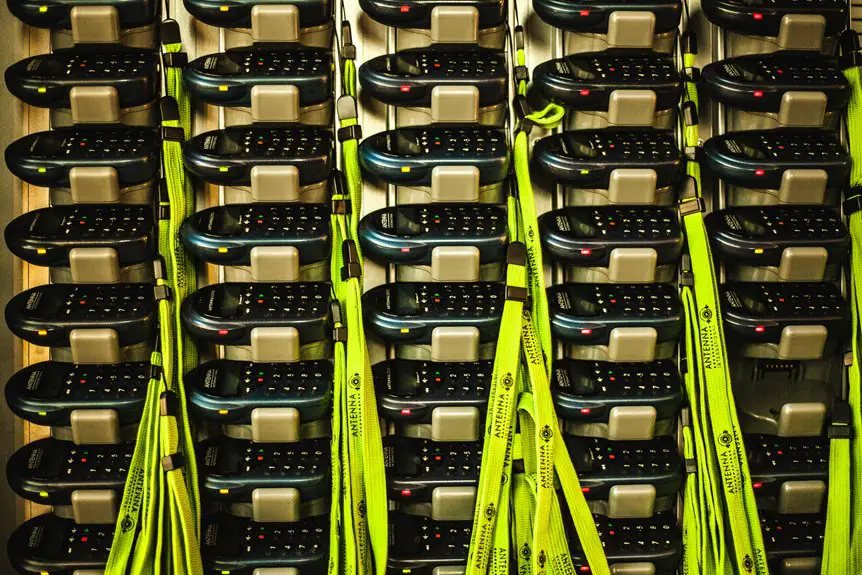When you have too many cables, start by gathering and assessing them. Identify their purposes, and separate them into groups: keep, donate, or discard. Invest in cable management solutions, like sleeves and clips, to tidy up your space. Get creative by repurposing old cables into unique items or art. Lastly, establish a regular maintenance routine to keep clutter at bay. Follow these steps, and you'll find even more ways to manage your cables effectively!
Key Takeaways
- Gather all cables, identify their purposes, and separate them into groups: keep, donate, or discard.
- Invest in cable management solutions like sleeves, clips, and boxes to keep cables organized and accessible.
- Repurpose old cables creatively, turning them into keychains, DIY charging stations, or decorative art.
- Research local recycling options and participate in e-waste events to dispose of unusable cables responsibly.
- Establish a monthly maintenance routine to review and sort cables, ensuring they remain tidy and functional.
Assess and Categorize Your Cables
When it comes to tackling a tangled mess of cables, the first step is to assess and categorize what you've got. Start by gathering all your cables in one place.
Next, identify each cable's purpose—charging, data transfer, or audio/video. This helps you understand what you really need. As you sort, separate them into groups: keep, donate, or discard. If a cable hasn't been used in months, it's likely time to let it go.
Labeling cables can also save you time in the future. Consider using color-coded tags or simple markers for easy identification.
Invest in Cable Management Solutions
To keep your cables organized and easily accessible, investing in cable management solutions is essential.
These tools not only declutter your space but also prolong the life of your cables. Here are four effective options to consider:
- Cable Sleeves: Bundle multiple cables together for a neat appearance and easier handling.
- Cable Clips: Secure cables to desks or walls, preventing tangles and keeping them within reach.
- Cable Boxes: Hide excess cables and power strips in a stylish box, maintaining a clean aesthetic.
- Cable Ties: Use reusable ties to keep cables organized and prevent them from becoming a jumbled mess.
Repurpose Old Cables Creatively
If you've got old cables lying around, don't toss them out just yet; they can be repurposed in creative ways that add both functionality and flair to your space.
Use plastic cable ties to organize your cords neatly, keeping your workspace clutter-free. You can also turn an old USB cable into a unique keychain or bracelet—just braid or twist it into a fun shape.
If you have spare audio cables, consider creating a DIY charging station by wrapping them around a wooden block to keep devices off the surface.
Lastly, think about using old HDMI cables as decorative wall art; simply mount them in interesting patterns.
With a little creativity, those old cables can find new life!
Recycle Cables Responsibly
Recycling cables responsibly is crucial for reducing electronic waste and protecting the environment.
Responsible cable recycling is essential for minimizing electronic waste and safeguarding our planet's health.
When it's time to part with those old cords, follow these steps to ensure they're disposed of properly:
- Check Local Regulations: Research your area's rules for electronic waste disposal; they often have specific guidelines.
- Find a Recycling Center: Locate a certified recycling center that accepts electronic cables. Many electronics stores also offer recycling programs.
- Participate in E-Waste Events: Look for community e-waste collection events. These are great opportunities to recycle multiple items at once.
- Donate Usable Cables: If your cables are still in good condition, consider donating them to local schools or charities.
Establish a Maintenance Routine
While it might seem overwhelming to manage your collection of cables, establishing a maintenance routine can make the process much easier.
Start by setting aside a specific time each month to review your cables. Check for any fraying, damage, or cables you no longer use. Sort them into keep, recycle, or donate piles.
Next, invest in cable organizers, like clips or boxes, to keep everything tidy. Label each cable with its purpose to avoid confusion later.
Regularly reassess your collection, especially after acquiring new devices. This way, you'll prevent clutter from building up again.
Frequently Asked Questions
How Can I Identify Which Cables Are Essential?
To identify essential cables, assess your devices and their connections. Prioritize cables that power your equipment or facilitate essential data transfer. Eliminate duplicates or those for unused devices, keeping only what you truly need.
What Are Some Innovative Storage Ideas for Cables?
You can use binder clips to organize cables on your desk, repurpose a shoe box for storage, or create a cable management wall with hooks. These innovative ideas keep your space tidy and accessible.
Are There Any Apps to Track My Cables?
Yes, there are several apps you can use to track your cables. Look for features like inventory management and barcode scanning, which help you easily locate and manage your collection without hassle.
How Often Should I Reassess My Cable Collection?
You should reassess your cable collection at least twice a year. Regularly checking helps you identify duplicates, outdated cables, or ones you no longer need, keeping your space organized and functional. It's a smart habit!
Can I Donate Unused Cables to Charities?
Yes, you can donate unused cables to charities! Many organizations appreciate electronic accessories. Just make sure they're in good condition, and check with the charity to ensure they accept such items before you drop them off.
